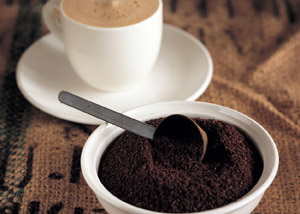Calibration of coffee grinder-Pegasus grinder adjusts the scale
Calibration of coffee grinder-Pegasus grinder adjusts the scale
Different bean grinders have different adjustment dials, so you should check the model of the coffee grinder and read the instructions carefully to determine the direction and strength of the dial. In general, if you keep in the habit of checking the settings of the bean grinder, you only need to make very small adjustments. As long as you move the turntable within 3 mm, you can change the thickness of the powder. Although 3mm is a very small number, the grinding time of the same coffee beans will change by 3-5 seconds to determine the direction you need to adjust (finer or thicker). Make sure there are enough coffee beans in the warehouse, and the valve between the warehouse and the sharpening knife is opened so that the coffee beans can fall smoothly into the grinding area.
Turn on the grinder for 10 seconds and discard the coffee powder (these are coffee powders that have not been adjusted).
Use the coffee powder to make a cup of coffee to ensure the accuracy of the steps of serving, flattening and pressing powder. The traditional method of making espresso (Ristretto) uses a water / flour ratio of 1:1 (i.e. 18 grams of coffee powder is used to make 18 grams of coffee) or 1:2 (i.e. 18 grams of coffee powder is used to make 36 grams of coffee), while a regular espresso uses a water / powder ratio of 1:2 (i.e., "Normale"). Test the quality of the coffee and the extraction time. Constantly adjust the dial to make the powder reach a perfect thickness.
The brand of the mill is different, and the thickness of the powder from the same scale identified by each brand is different, which can only be adjusted from your cooking method. At the same cooking temperature, the powder is thicker, the extraction time can be longer, the powder is finer, and the extraction time can be shorter. Basically, regardless of the variety, siphon, hand-made sugar-sized coffee powder is more appropriate, while semi-automatic Italian machines need to be ground to flour-like coffee grinders of different brands. The thickness of the powder milled on the same scale marked by each brand is different and can only be adjusted from your brewing method. At the same cooking temperature, the powder is thicker, the extraction time can be longer, the powder is finer, and the extraction time can be shorter. Basically, regardless of the variety, siphon and hand-made coffee powder the size of sugar is more appropriate, while semi-automatic espresso machines need to be ground to flour-like coffee powder.
If you are satisfied with my answer, I hope you can judge it this way if you are satisfied with my answer. For example, if you flush it by hand, the recommended medium scale is slightly thicker than sugar. If you rush out with obvious astringency or excessive extraction, it may be fine and slow, you can try to make it thicker, but because there are too many variables, you can only move one variable at a time. That is, when there is extraction, you adjust the technique, the speed of water injection, the number of circles, the size of the water column, the thickness of the powder, the temperature, and so on, but only one of these variables can be changed. if it is more obvious, you can first consider that the thickness of the powder is a variable. what we all use is different, not only because of different machines, but also because of the influence of extraction techniques.
For example, hand punch, scale is a variable, speed, technique, temperature, bean baking degree, these are all variables, as long as I am different from one of you, the scale is meaningless, the result is different.

Important Notice :
前街咖啡 FrontStreet Coffee has moved to new addredd:
FrontStreet Coffee Address: 315,Donghua East Road,GuangZhou
Tel:020 38364473
- Prev

The difference between cleaning tablets and detergent tablets of Yuri coffee machine
The difference between Yuri coffee machine cleaning tablets and detergent tablets another way to produce more pressure than 1.5 atmospheric pressure is to use compressed air. For example, a home coffee machine in Milanes collector Ambrogio Fumagalli uses an air pump to pressurize hot water for brewing coffee (during World War II). In 1938, Francesco IIIy made llletta.
- Next

Introduction to the baking scale flavor of Colombian Ramon coffee beans in Starbucks
The baking scale flavor of Colombian Ramon coffee beans in Starbucks introduces that Colombia is one of the three largest coffee producers in the world. Colombia is the only country in South America with Pacific and Caribbean coastlines. Agricultural products include coffee, fresh cut flowers, bananas, rice, tobacco, cotton, sugar, cocoa beans, oil, vegetables, trees and shrimp. Columby
Related
- What is the Philharmonic pressure? How to use Philharmonic pressure to make delicious coffee
- Why does a hand grinder have more fine powder than an electric grinder?
- In addition to the hot mom, what is the difference between the versions of EK43 | ditting and Mahdi ek43?
- What kind of equipment do you need to make coffee by hand? Introduction to novice starter cooking equipment tools
- Espresso needs to be ground how thick and thin scale entry Italian Coffee Machine Bean Grinder investigation and Grinding course
- How much does it cost to open a small private cafe? How much does it cost to learn coffee? How to operate it?
- The difference between the flavor characteristics of hand-brewed coffee and coffee maker is hand-brewed coffee really better than coffee maker? Can I use a coffee machine to make coffee beans by hand?
- The difference between 01 and 02 of hario v60 filter cup what is the difference between 01 and 02 filter cup opening and cooking flavor
- What's the difference between the smart cup and the French kettle? Which is better, the French kettle or the Smart Cup?
- What's the difference between a smart cup and a V60 filter cup? The difference between the taste of smart cup and hand-brewed coffee

